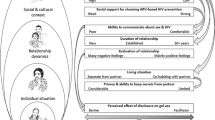Abstract
The inconclusive results of past trials and recent findings of partial protection of Tenofovir 1% gel underscore the need to better understand product adherence in microbicide trials. This study aimed to identify factors predicting couples’ ability to sustain topical gel and condom use during clinical trial participation. We enrolled 100 Indian participants of a randomized, controlled safety trial of Tenofovir 1% gel (CT cohort) and 100 similar women who were ineligible or declined trial participation (NCT cohort). Compared to the NCT cohort, CT women reported higher baseline condom use, more positive attitudes towards condoms and higher levels of protection efficacy. While NCT condom use remained low, CT condom use increased dramatically during the study. Reported gel consistency was higher than condom consistency. Individual and couple-related factors predicted condom consistency and interest in future gel use, but not gel consistency. Findings could inform trial recruitment strategies and product introduction.

Similar content being viewed by others
References
Uckun FM, D’Cruz OJ. Prophylactic contraceptives for HIV/AIDS. Hum Reprod Update. 1999;5(5):506–14.
Elias C, Coggins C. Acceptability research on female-controlled barrier methods to prevent heterosexual transmission of HIV: where have we been? where are we going? J Wom Health Gend Base Med. 2001;10(2):163–73.
Weller S, Davis K. Condom effectiveness in reducing heterosexual HIV transmission. Cochrane Database Syst Rev. 2002;(1):CD003255.
Steiner MJ, Cates W Jr. Condoms and sexually-transmitted infections. N Engl J Med. 2006;354(25):2642–3.
Steiner MJ, Cates W Jr, Warner L. The real problem with male condoms is nonuse. Sex Transm Dis. 1999;26(8):459–62.
Misovich SJ, Fisher JD, Fisher WA. Close relationships and elevated HIV risk behavior: evidence and possible underlying psychological processes. Rev Gen Psychol. 1997;1(1):72–107.
Auvert B, Taljaard D, Lagarde E, Sobngwi-Tambekou J, Sitta R, Puren A. Randomized, controlled intervention trial of male circumcision for reduction of HIV infection risk: the ANRS 1265 Trial. PLoS Med. 2005;2(11):e298.
Bailey RC, Moses S, Parker CB, et al. Male circumcision for HIV prevention in young men in Kisumu, Kenya: a randomised controlled trial. Lancet. 2007;369(9562):643–56.
Gray RH, Kigozi G, Serwadda D, et al. Male circumcision for HIV prevention in men in Rakai, Uganda: a randomised trial. Lancet. 2007;369(9562):657–66.
Wawer MJ, Makumbi F, Kigozi G, et al. Circumcision in HIV-infected men and its effect on HIV transmission to female partners in Rakai, Uganda: a randomised controlled trial. Lancet. 2009;374(9685):229–37.
Hirsch JS, Meneses S, Thompson B, Negroni M, Pelcastre B, del Rio C. The inevitability of infidelity: sexual reputation, social geographies, and marital HIV risk in rural Mexico. Am J Public Health. 2007;97(6):986–96.
Smith DJ. Modern marriage, men’s extramarital sex, and HIV risk in southeastern Nigeria. Am J Public Health. 2007;97(6):997–1005.
Parikh SA. The political economy of marriage and HIV: the ABC approach, “safe” infidelity, and managing moral risk in Uganda. Am J Public Health. 2007;97(7):1198–208.
Gangakhedkar RR, Bentley ME, Divekar AD, et al. Spread of HIV Infection in married monogamous women in India. J Am Med Assoc. 1997;278:2090–2.
Dunkle KL, Stephenson R, Karita E, et al. New heterosexually transmitted HIV infections in married or cohabiting couples in urban Zambia and Rwanda: an analysis of survey and clinical data. Lancet. 2008;371(9631):2183–91.
Abdool Karim Q, Abdool Karim SS, Frohlich JA, et al. Effectiveness and safety of tenofovir gel, an antiretroviral microbicide, for the prevention of HIV infection in women. Science. 2010;329(5996):1168–74.
Van Damme L, Govinden R, Mirembe FM, et al. Lack of effectiveness of cellulose sulfate gel for the prevention of vaginal HIV transmission. N Engl J Med. 2008;359(5):463–72.
Skoler-Karpoff S, Ramjee G, Ahmed K, et al. Efficacy of Carraguard for prevention of HIV infection in women in South Africa: a randomised, double-blind, placebo-controlled trial. Lancet. 2008;372(9654):1977–87.
Family Health International. Phase 3 trial in Nigeria evaluating the effectiveness of savvy gel in preventing HIV infection in women will close, August 28, 2006.
Stover K. Anti-HIV gel shows promise in large-scale study in women. National Institute of Allergy and Infectious Diseases (NIAID).
Microbicides Development Programme. HIV ‘prevention’ gel PRO 2000 proven ineffective. http://www.mdp.mrc.ac.uk/archive.html, accessed December 29, 2009.
van de Wijgert J, Jones H. Challenges in microbicide trial design and implementation. Stud Fam Plann. 2006;37(2):123–9.
Tolley EE, Severy LJ. Integrating behavioral and social science research into microbicide clinical trials: challenges and opportunities. AJPH. 2006;96(1):79–83.
Tolley EE, Eng E, Kohli R, et al. Examining the context of microbicide acceptability among married women and men in India. Cult, Health Sex. 2006;8(4):351–69.
Marlow HM, Tolley EE, Kohli R, Mehendale S. Exploring married couples’ sexual communication within the context of a microbicide clinical trial and acceptability study in pune, India. Cult, Health Sex. 2010;12(8):899–912.
Catania J, Kegeles S, Coates T. Towards an understanding of risk behavior: an AIDS risk reduction model (ARRM). Health Educ Q. 1990;17:53–72.
Potts M. Thinking about vaginal microbicide testing. AJPH. 2000;90(2):188–90.
Wittkowski K. Further thoughts about vaginal microbicide testing. AJPH. 2000;90(2):1155–6.
de Zoysa I, Elias CJ, Bentley ME. Ethical challenges in efficacy trials of vaginal microbicides for HIV prevention. AJPH. 1998;88(4):571–5.
Graham SM, Shah PS, Aesch ZC, Beyene J, Bayoumi AM. A systematic review of the quality of trials evaluating biomedical HIV prevention interventions shows that many lack power. HIV Clin Trials. 2009;10(6):413–31.
Acknowledgments
This study was conducted with support from the United States Agency for International Development (USAID) through Cooperative Agreement GPO-A-OO-05-00022-00; however, the views expressed do not necessarily reflect those of USAID.
Author information
Authors and Affiliations
Corresponding author
Rights and permissions
About this article
Cite this article
Tolley, E.E., Tsui, S., Mehendale, S. et al. Predicting Product Adherence in a Topical Microbicide Safety Trial in Pune, India. AIDS Behav 16, 1808–1815 (2012). https://doi.org/10.1007/s10461-011-0036-6
Published:
Issue Date:
DOI: https://doi.org/10.1007/s10461-011-0036-6




